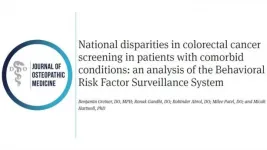(Press-News.org) BURLINGTON, VT -- In the aftermath of George Floyd's 2020 murder by former police officer Derek Chauvin, many families may find themselves actively engaging in--or uncomfortably fumbling around--discussions about race. For white parents looking to clearly communicate antiracist ideologies with their preadolescent children, a new study offers some insight.
"There's a difference between saying race "shouldn't" matter and race "doesn't" matter," explains Jamie Abaied, professor of developmental psychology at the University of Vermont and lead author of the study, co-authored by Sylvia Perry, a professor of psychology at Northwestern University. Though "shouldn't" and "doesn't" may seem similar, the study reveals just how different they can be.
Released online by the journal Cultural Diversity and Ethnic Minority Psychology on Monday, the study analyzes data collected in summer 2015 (in the weeks immediately following the Charleston church shooting) from a sample of white American parents responding to questions about how they talk about race with their children, ages 8-12. It aims to understand whether or not white American parents communicate contradictory messages about race to their children; and if so, how and why?
The short answer: Yes, they do--but probably unintentionally. The study found that more than a third of parents communicated mixed messages about race, whereas the remaining two-thirds either communicated consistent ideas about their racial ideology or simply communicated no ideas about race at all. "Before we really develop specific interventions to help parents talk to their kids about race, we need to know what they're currently saying to their kids and how they're currently thinking about these discussions," she says. Until now, there hasn't been much research on that, particularly among parents of children older than age 7.
"When parents offered mixed messages about race, they were saying really positive things like, 'Racism is real and it's wrong,' but they were also saying that race isn't that important, or that 'It's only skin deep,' which is a type of thinking that researchers call colorblindness," she explains. About half the parents endorsed colorblindness at least once in their responses, and more than twenty-one percent of parents in the study only communicated colorblind thinking to their children.
Though not the focus of the study, these findings add to an existing body of psychological research that recalibrates the scales from simply "racist" or "not racist," to "racist" or "counteractive to racist." It's a concept known as antiracism, and it significantly impacts today's understanding of racial colorblindness.
The study describes colorblindness as "a modern form of racism, which can take the form of either color-evasion (claiming to 'not see' race) or power evasion (denying that racial inequality is a reality)." It can downplay race, imply that it isn't important, or divert awareness. And according to Abaied, it's the most problematic takeaway from the study.
"The problem with colorblindness is that race is real. It has real effects on people's lived experiences. If you don't think race is real, it makes it easier to go a step further and believe that racism isn't real," Abaied says. "I think some of the parents were well-meaning and trying to voice egalitarian beliefs, such as, 'I believe people of different races should be treated equally,' which is different from, 'I don't see color, everybody's equal.' In doing that, they are implying that race doesn't matter. The difference is very nuanced, but also very important."
"Colorblindness is not a pathway to racial equality," she adds. "There's a false belief that if we just stop talking about race, everything will be fine." In fact, Abaied found that most white parents, sixty-three percent, reported that they didn't discuss race-related news with their children at the time, which included the killings of Trayvon Martin, Michael Brown and Freddie Gray in addition to the 2015 Charleston church shooting.
Reasons for that ranged from parents wanting to shield their children from difficult topics--"No, a child should not be told about death and murder. Those are adult topics," one parent said--to perceptions of relevance--"I have not. Why would I bring that up?" stated another.
"The results indicate that white parents have the potential to be agents of change that socialize color conscious beliefs in their children, but many are reinforcing the current system of colorblind indifference to racial inequality," the study explains.
However, the researchers also found that nearly thirty-four percent of participants exclusively communicated in color conscious ideologies, which directly challenge colorblindness. In practice, that looks like white parents "celebrating racial diversity rather than minimizing it, openly acknowledging rather than denying the impact of race on people's lives through discrimination and structural racism, and advocating for equal rights and treatment across different racial groups," the study explains.
Many parents voiced this belief in response to a hypothetical question that asked what they would say to their child if they encountered an incident of race-related prejudice together. Roughly half the parents endorsed the idea that people should receive equal treatment, regardless of race. "I would tell her that what she witnessed was wrong and only hurtful people act like that and we should accept everyone as equals," one parent stated.
However, another parent stated: "I would tell her that everybody is different and the color of your skin is no reason to treat anyone any differently." Both parents endorse equal treatment regardless of race, but differ on how they define the incident itself as "wrong" to their children--only the former explicitly mentioned race in their answer.
Abaied sees the study as a first step toward developmental trainings and programs designed to help guide parents--or possibly even teachers--through these messaging nuances and straight into constructive, intentional conversations about race. "Kids' ideas about race start to solidify in adolescence, so it's not too late to have these conversations during the elementary school years. I think it would be good for parents to talk about this early," she says.
Though family conversations are just one piece of the puzzle to be solved, Abaied points out by engaging multiple generations through one conversation, those conversations have potential to be highly impactful.
Follow-up research to the study is currently underway, with Abaied and her team analyzing a new data set for the study collected in 2020 (after the murder of George Floyd) that will enable them to track and compare progress over time.
INFORMATION:
CHICAGO--May 3, 2021-- Patients with one or more health conditions are more likely to be screened for colorectal cancer than those without comorbidities, according to new research in the Journal of Osteopathic Medicine. However, patients with five or more health conditions are also less likely to be screened than patients with two to four health conditions.
Colorectal cancer is the second leading cause of cancer death in the U.S. resulting in more than 53,000 deaths each year. Regular colorectal screenings, whether colonoscopy or at-home stool test, ...
Chestnut Hill, MA (5/3/2021) -- The billion-year-old fossil of an organism, exquisitely preserved in the Scottish Highlands, reveals features of multicellularity nearly 400 million years before the biological trait emerged in the first animals, according to a new report in the journal Current Biology by an international team of researchers, including Boston College paleobotanist Paul K. Strother.
The discovery could be the "missing link" in the evolution of animals, according to the team, which included scientists from the U.S., United Kingdom, and Australia. The microfossil, discovered at Loch Torridon, contains two distinct cell types and could be the earliest example of complex multicellularity ...
ITHACA, N.Y. - A new Cornell University-led study examines how temperature affects fishing behavior and catches among inland fisher households in Cambodia, with important implications for understanding climate change.
The research, which used household surveys, temperature data and statistical models, revealed that when temperatures rise, people fish less often. At the same time, the study's authors indirectly found that stocks of fish and other aquatic foods also rise with temperatures, leading to slightly larger catches each time peopled fished. Without careful analysis, it would appear that overall fish catches appear unchanged annually, when in fact, more nuanced dynamics are at play.
The study highlights why it's necessary when studying changing environmental ...
Researchers at the University of Haifa, the Weizmann Institute and the Centre for Genomic Regulation (CRG) have built the first atlas of all of the different types of cells in Stylophora pistillata, a reef-building stony coral native to the Indo-Pacific oceans. Published today in the journal Cell, the study is the first to detect the presence of specialized immune cells in corals.
The findings provide new insights into the molecular biology and evolution of corals and will aid present and future conservation efforts to protect coral reef ecosystems threatened by rising temperatures and ocean acidification.
The map reveals that Stylophora pistillata has 40 different cell types over the three main stages ...
What The Study Did: The findings of this study suggest an association between county-level income inequality and COVID-19 cases and deaths.
Authors: Michelle C. Odden, Ph.D., of Stanford University in Stanford, California, is the corresponding author.
To access the embargoed study: Visit our For The Media website at this link https://media.jamanetwork.com/
(doi:10.1001/jamanetworkopen.2021.8799)
Editor's Note: The article includes conflict of interest disclosures. Please see the article for additional information, including other authors, author contributions and affiliations, conflict of interest and financial disclosures, and funding and support.
INFORMATION:
Media advisory: The full study is linked to this news release.
Embed this link to provide your readers free access ...
What The Study Did: This study of registry patients evaluates whether any changes in the in-hospital COVID-19 mortality rates during the first nine months of the pandemic were associated with individual characteristics of patients with COVID-19.
Authors: Gregory A. Roth, M.D., M.P.H., of the University of Washington in Seattle, is the corresponding author.
To access the embargoed study: Visit our For The Media website at this link https://media.jamanetwork.com/
(doi:10.1001/jamanetworkopen.2021.8828)
Editor's Note: The article includes conflict of interest and funding/support disclosures. Please see the article for additional information, including other authors, author contributions and affiliations, ...
What The Study Did: Study results suggest underuse of coronavirus testing in patients with fever may contribute to community transmission.
Authors: Mark J. Pletcher, M.D., M.P.H., of the University of California, San Francisco, is the corresponding author.
To access the embargoed study: Visit our For The Media website at this link https://media.jamanetwork.com/
(doi:10.1001/jamanetworkopen.2021.8500)
Editor's Note: The article includes conflict of interest and funding/support disclosures. Please see the article for additional information, including other authors, author contributions and affiliations, conflict ...
What The Study Did: Households and not schools were the major route of transmission among children and youths with COVID-19 in Hong Kong, these study results suggest.
Authors: Mike Yat Wah Kwan, M.Sc., M.R.C.P.C.H., of the Princess Margaret in Hong Kong, and Patrick Ip, M.P.H., of the University of Hong Kong, are the corresponding authors.
To access the embargoed study: Visit our For The Media website at this link https://media.jamanetwork.com/
(doi:10.1001/jamanetworkopen.2021.8824)
Editor's Note: The article includes conflict of interest and funding/support disclosures. Please see the article for additional information, including other authors, author contributions and affiliations, ...
What The Study Did: Inquiries to a child abuse hotline during the COVID-19 pandemic compared with inquiries during the same period the previous year are assessed in this study.
Authors: Robin Ortiz, M.D., of the University of Pennsylvania in Philadelphia, is the corresponding author.
To access the embargoed study: Visit our For The Media website at this link https://media.jamanetwork.com/
(doi:10.1001/jamapediatrics.2021.0503)
Editor's Note: The article includes conflict of interest and funding/support disclosures. Please see the article for additional information, including other authors, author contributions and affiliations, conflict of interest and financial disclosures, and funding and support.
INFORMATION:
Media advisory: The full study is linked to this news release.
Embed ...
What The Study Did: Changes in adolescents' use of e-cigarettes, cannabis and alcohol and in physical activity behaviors following the COVID-19 stay-at-home order in California are examined in this study.
Authors: Benjamin W. Chaffee, D.D.S., M.P.H., Ph.D., of the University of California, San Francisco, is the corresponding author.
To access the embargoed study: Visit our For The Media website at this link https://media.jamanetwork.com/
(doi:10.1001/jamapediatrics.2021.0541)
Editor's Note: The article includes conflict of interest and funding/support disclosures. Please see the article for additional information, including other authors, author contributions and affiliations, ...


